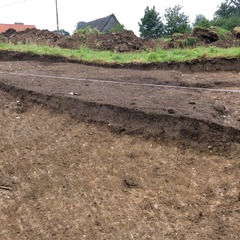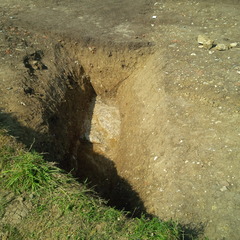Basic Information
- Drainage ditch
Contexts
Narrative
-
- Cutting into a chalky layer (10024) was the curving ditch feature, F1005 with flattened banks on either side of it that had been observed running through the Earthworks Field. The ditch feature extended on a NW-SE orientation and was filled with mid-yellow greyish brown clayey sand (10019) with inclusions of chalk, flint nodules, pebbles, shell, bone and charcoal inclusions. On either side of the ditch cut [10023] lay bank deposits (10004 & 10009) filled with mid yellow-brown sandy clay with inclusions of charcoal flecks, pebbles and chalk fragments. Further flattening of the banks was displayed through an upper ditch deposit (10003) overlaying the ditch fill (10019) and parts of the northern bank (10004). Filled with mid greyish-brown clayey sand, the upper ditch deposit (10003) indicated a later alluvial deposit.
-
- Kezia Evans
- 5-12-2014
Dating Narrative
-
- The artefacts discovered within the ditch fill were of mixed dates, including medieval pottery (SF 24, 27 & 33) which mostly dated to the early 18th Century and a bone knife handle provisionally dated to 1570-1600 (SF 36). The bank deposit on the northern side of the ditch (10004) overlay the ditch fill (10019), and produced some finds of mixed dates, including a Nuremberg rose/orb jetton dating to the late 16th Century (SF 1), an 18th Century wire and gold button (SF 44) and late 17th Century pottery sherds indicating later working and flattening of the banks. The bank deposit on the southern side of the ditch produced finds of a range of dates including a possible pair of tweezers (SF45) which could date from Roman to early Medieval (200-700AD) and a horse fitting (SF8) which could be dated anywhere from the post-medieval to early modern (1700-1950AD) The high density of artefacts ranging from medieval to post-medieval in the bank indicates evidence of the maintenance of the bank.
-
- Kezia Evans
- 7-10-2014
Matrix
-
- [not set]
- [not set]




